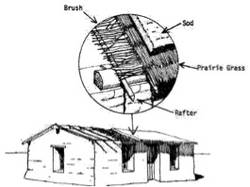
Isabel Reekie, in her fine book, “Along the Old Melita Trail” estimates that ninety five percent of the first settlers started their homesteading life in a sod hut.
Trees were scarce, wood was expensive, and fetching it was very time consuming. Getting that first crop planted was the priority.
Soddies were the ultimate in low-cost housing.
Should you want to take advantage of this “ground-breaking” technology, here’s a quick guide:
Advance Preparations
- Pick a little rise of land with good drainage.
- Find a bit of lower land, a soggy slough bottom perhaps where the grass roots are thick and tough.
Collect the Sod
- Use a plow to cut a smooth furrow 30 or 40 cm wide.
- Cut the sod into 50 cm lengths.
- Repeat for quite a while.
Start Building
- Lay two tiers of sod side by side, breaking the joints, then lay a second course crossways, binding the wall together.
- Repeat (for quite a while) until the walls are about two metres high.
Try to include a few windows and a door by using planks as frames, when the wall reaches the proper height. Lay sod around the sides and on top of boards placed above the frame. A gap, left at the top, above the frame, can be filled with rags or grass, which allows the sod to settle without crushing the glass panes in the window. Pegs, driven into the sod through holes in the frames, hold them in place. Don’t overdo this. One door is plenty and glass for windows might be hard to come by.
The Roof
- Place strong poles down the centre of the building to support a ridge pole.
- Place rafters of poles from the ridge pole to the walls.
- Start with a layer of willow (hay could be used if necessary), then top with sod.
Optional Luxuries
- If lumber is available treat yourself to a wood floor, if not, packed dirt will have to do for now.
- If you can afford it, of course a wood roof would certainly be nice – use two layers of boards with tar paper between them.
- For a deluxe roof you might chose a car-roofed design, slightly rounded like a railway car. This is done by having the roof boards bent over a ridge pole set slightly higher than the wall height.
- Interior walls can be smoothed and even coated with whitewash or plastered with clay.
- Heavy cotton can be stretched over ceilings and wall to give it that cozy, finished look.
*Cautionary Notes:
There are a few things you might watch out for.
The roofing system comes with no guarantee. It definitely keeps the sun out, and keeps most of the snow out, but rain is tricky. One pioneer mom suggested using an oilcloth tablecloth, so you can put various belongings and offspring under the table when the roof leaks. Good advice.
When conditions are dry, the branches and hay in your roof make excellent kindling should a stray spark hit them. You don’t want to see how that works.
Changing Consumer Tastes
Soddies, though, soon went out of favour? Perhaps people preferred a drier, less flammable home where one wasn’t weren’t surrounded by…dirt? In any case most people used their sod huts for just a few years before upgrading to wood.
. . . . .
Author: Ken Storie
Sources:
Nebraska State Historical Society. Educational Leaflet #3: The Sod House. http://www.usgennet.org/usa/ne/topic/resources/NSHS/EDLFT/edlft03.html Reekie Isabel M. Along the Old Melita Trail. Modern Press, 1965
